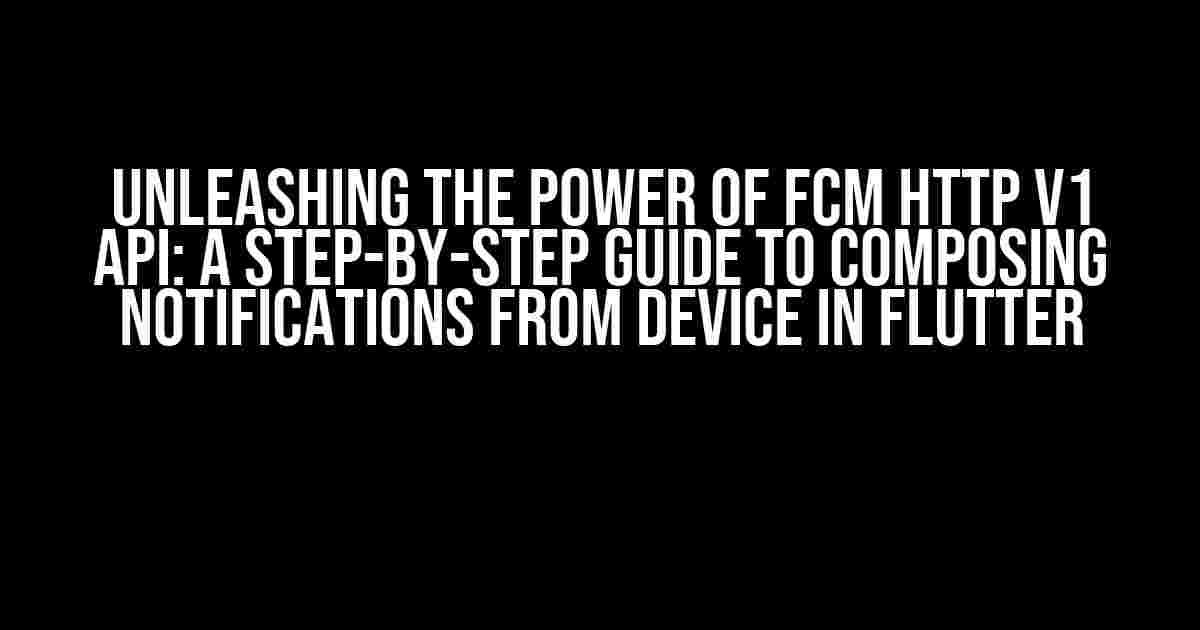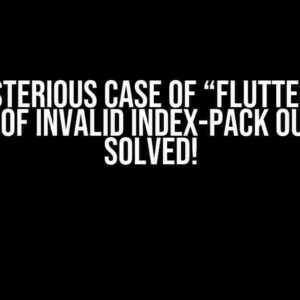Are you tired of relying on the Firebase console to send notifications to your Flutter app users? Do you want to take control of your notification system and compose notifications from your device instead? Look no further! In this comprehensive guide, we’ll walk you through the process of using the FCM HTTP v1 API to send notifications from your Flutter device.
Why Use FCM HTTP v1 API?
Before we dive into the implementation details, let’s quickly discuss why using the FCM HTTP v1 API is a game-changer for your Flutter app.
- Flexibility and Control**: By using the FCM HTTP v1 API, you can compose and send notifications from your device, giving you complete control over the notification content, timing, and targeting.
- Improved Performance**: Sending notifications from your device can reduce the load on your server and improve the overall performance of your app.
- Enhanced Security**: By handling notification composition and sending on the device, you can reduce the risk of unauthorized access to your Firebase console.
Prerequisites
Before we begin, make sure you have the following prerequisites in place:
- Flutter 2.0 or later**: Ensure you’re using the latest version of Flutter to take advantage of the FCM HTTP v1 API.
- FCM setup**: Set up Firebase Cloud Messaging (FCM) in your Flutter project, including registering your app and obtaining the necessary configuration files.
- HTTP client library**: Choose an HTTP client library for Flutter, such as `http` or ` dio`, to make API requests to the FCM HTTP v1 API.
Obtaining the FCM Server Key
To interact with the FCM HTTP v1 API, you’ll need to obtain the FCM server key from the Firebase console.
- Log in to the Firebase console and navigate to the Project settings section.
- Click on the Cloud Messaging tab.
- Scroll down to the Legacy API keys section.
- Click on the Show button to reveal the FCM server key.
- Copy the FCM server key, as you’ll need it later.
Composing the Notification Request
To send a notification using the FCM HTTP v1 API, you’ll need to compose a request payload in JSON format. Here’s an example of a basic notification request:
{
"to": "/topics/all",
"notification": {
"title": "Hello from Flutter!",
"body": "This is a notification sent from the device using FCM HTTP v1 API."
}
}In this example, we’re targeting the `/topics/all` topic, which is a default topic created by FCM for your app. You can replace this with a custom topic or a specific device token.
Available Request Fields
The FCM HTTP v1 API supports a range of request fields to customize your notification. Here are some of the most commonly used fields:
| Field | Description |
|---|---|
| to | The target of the notification, such as a topic or device token. |
| notification | The notification payload, including title, body, and other attributes. |
| data | Custom key-value pairs to be included in the notification payload. |
| priority | The priority of the notification, with higher values indicating higher priority. |
Sending the Notification Request
Now that you have your notification request payload, it’s time to send it to the FCM HTTP v1 API using your chosen HTTP client library.
import 'package:http/http.dart' as http;
Future sendNotification() async {
final String fcmServerKey = 'YOUR_FCM_SERVER_KEY';
final String notificationJson = jsonEncode({
'to': '/topics/all',
'notification': {
'title': 'Hello from Flutter!',
'body': 'This is a notification sent from the device using FCM HTTP v1 API.'
}
});
final Uri url = Uri.parse('https://fcm.googleapis.com/v1/projects/YOUR_PROJECT_ID/messages:send');
final headers = {
'Content-Type': 'application/json',
'Authorization': 'Bearer $fcmServerKey',
};
final response = await http.post(url, headers: headers, body: notificationJson);
if (response.statusCode == 200) {
print('Notification sent successfully!');
} else {
print('Error sending notification: ${response.statusCode}');
}
}
Replace `YOUR_FCM_SERVER_KEY` with the FCM server key you obtained earlier, and `YOUR_PROJECT_ID` with your Firebase project ID.
Handling Errors and Edge Cases
When working with the FCM HTTP v1 API, it’s essential to handle errors and edge cases to ensure reliable notification delivery.
- Error Handling**: Catch and handle HTTP errors, such as 401 Unauthorized or 403 Forbidden, to prevent crashes and unexpected behavior.
- Rate Limiting**: Be mindful of FCM’s rate limits to avoid being blocked or throttled. Aim for a reasonable notification volume to avoid overwhelming the FCM servers.
- Device Token Management**: Properly handle device token rotation, invalidation, and revocation to ensure notifications are delivered to the correct devices.
Conclusion
In this comprehensive guide, we’ve covered the steps to compose and send notifications from your Flutter device using the FCM HTTP v1 API. By following these instructions, you’ll be able to take control of your notification system, improve performance, and enhance security.
Remember to adapt this guide to your specific use case, and don’t hesitate to reach out if you encounter any issues or have further questions.
Additional Resources
For further reading and exploration, check out the following resources:
- FCM HTTP v1 API Documentation**: Dive deeper into the FCM HTTP v1 API documentation for a complete list of available request fields and error codes.
- FlutterFire FCM Plugin**: Explore the official FlutterFire FCM plugin, which provides a convenient interface for working with FCM in your Flutter app.
Happy coding, and may your notifications reach your users seamlessly!
Frequently Asked Question
Get ready to unlock the secrets of composing notifications from your device instead of the Firebase console in Flutter using FCM HTTP v1 API!
What is the main difference between FCM HTTP v1 API and the Firebase console when it comes to sending notifications?
The main difference is that FCM HTTP v1 API allows you to send notifications directly from your device or server, giving you more control and flexibility, whereas the Firebase console is a web-based interface that limits your control over the notification process.
What are the required credentials to use FCM HTTP v1 API to compose notifications?
You’ll need a Firebase project, a service account key file, and the FCM API enabled on your Google Cloud Console. You can find more information on how to set up these credentials in the Firebase documentation.
How do I authenticate with the FCM HTTP v1 API to send notifications?
You can authenticate using the `Authorization` header with a Bearer token, which is obtained by creating credentials for a service account and using the `GoogleAuthentication` package in Flutter.
What is the format of the request payload when composing a notification using FCM HTTP v1 API?
The request payload should be in JSON format and contain the notification details such as the title, message, and target device or devices. You can find the full list of available fields in the FCM HTTP v1 API documentation.
Are there any specific libraries or packages I need to use in Flutter to interact with the FCM HTTP v1 API?
Yes, you’ll need to use the `http` package to make HTTP requests to the FCM API, and the `json` package to encode and decode JSON data. You may also want to use a library like `firebase_messaging` to handle notification-related tasks.


